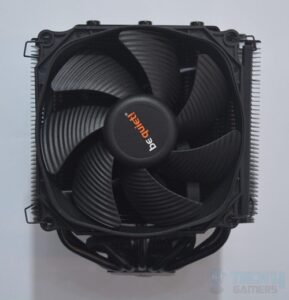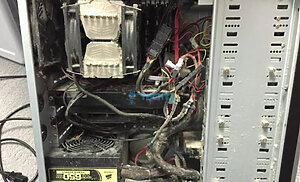When applied correctly, thermal paste enhances CPU cooling by enabling proper heat transfer.[1] However, once it runs dry, your GPU or CPU will start overheating due to inadequate cooling, which can cause damage to the component.[2] So, you should replace it immediately. So, how long does a thermal paste last? Well, it depends on several factors, such as the quality of the paste and whether you applied it correctly or not.
Key Takeaways
- It is best to replace thermal paste every 2 to 3 years for optimal CPU/GPU performance.
- Replace it when the CPU/GPU is overheating or before overclocking.
- Store the extra paste at room temperature and keep the cap intact to prolong its shelf life.
Thermal pastes have a limited lifespan, and their expiry date is mentioned chiefly on the tube or the box. This lifespan varies with brands and quality. Premium ones can last up to 7 years on a chip without needing replacement.

Generally, most thermal compounds can last up to 5 years on your CPU, but manufacturers such as Cooler Master recommend replacing them every two to three years.[3] That’s because different outside factors can cause it to dry out quicker than what the manufacturers rate it for.
Factors Affecting Its Lifespan
While researching, I learned about a few crucial aspects that may negatively affect the lifespan of thermal paste.
Ambient Temperatures
Room temperature is a crucial factor in determining the frequency of thermal paste replacement. The ambient temperature, unless controlled by air conditioning, influences the operating temperature of your PC.
Based on experience, I recommend running computers at room temperature (around 21°C). Higher room temperatures may force you to replace the thermal paste sooner than normal and cause the CPU to overheat.[4]
Daily Workloads
Long hours of CPU-intensive workloads, particularly CPU-heavy games or productivity tasks, can be another reason. This isn’t a significant issue, especially if your CPU temperatures are within safe limits; however, it might cause the thermal paste to dry out faster in the long run.
Inadequate Cooling Solution
Insufficient cooling from a less powerful CPU cooler can result in higher temperatures during heavy workloads. Prolonged exposure to higher CPU temperatures may cause it to dry out quicker. Therefore, install a good-quality CPU cooler to maintain optimal temperatures and extend the lifespan of thermal paste.

Dust Buildup Inside Your PC
Dust settling inside your case, especially on the CPU cooler, can impact the thermal paste’s normal operation. Dust on and around the components can interrupt the airflow, while dust on your CPU cooler can affect its ability to dissipate heat efficiently.
Make sure the inside of your case is free from dust by using compressed air or an air blower. It can also be done without using compressed air.[5] Also, clean the PC fans regularly to avoid dust buildup.

When To Replace It?
There are several instances where you may need to apply a new layer of thermal paste and clean the older layer off the CPU or your GPU, such as when;
- The CPU shows signs of overheating very frequently.
- Reinstalling your CPU Cooler.
- Overclocking your CPU or GPU.
- The older application has dried out.
How Long Does It Last in The Tube?
Regarding shelf life, thermal paste should not be stored for more than two years. It differs according to local temperatures, but I have a few guidelines you can follow to prolong it, like keeping the cap closed to prevent air exposure and oxidation and storing it at room temperature, away from direct sunlight.
Replacing the thermal paste every two to three years is a practice I follow to ensure maximum CPU cooler performance. I buy one gram tube of thermal paste whenever required since it is enough for three applications. Doing so avoids wastage.
More Helpful Resources By tech4Gamers:
References:
-
How does heat sink compound (thermal paste) work? Retrieved from https://www.chemtronics.com/how-does-heat-sink-compound-thermal-paste-work
-
Can Bad or Low-Quality Thermal Paste Cause Overheating? (Solution to Fix It!). Retrieved from https://koolingmonster.com/insights/can-bad-or-low-quality-thermal-paste-cause-overheating-solution-to-fix-it
-
Cooler Master. Does thermal compounds (grease or paste) have an expiration problem? Retrieved from https://landing.coolermaster.com/faq/does-thermal-compounds-grease-or-paste-has-an-expiration-problem/
-
Acer Community. Acer Predator Helios 16 CPU overheating. PH(16-71) when playing games on turbo or performance mode. Retrieved from https://community.acer.com/en/discussion/688758/acer-predator-helios-16-cpu-overheating-ph16-71-when-playing-games-on-turbo-or-performance-mode
-
UNIVERSITY of WISCONSIN–MADISON. How to clean your computer & tech gear. Retrieved from https://it.wisc.edu/news/how-to-clean-your-computer/
FAQs
It’s a good practice to replace it once every two or three years or when you start facing high CPU temperatures out of the blue.
The paste should have the same consistency and thickness as when you first applied it. Do not apply if it looks dried out, solid, or flaky, and get a new one.
If you’re facing high CPU or GPU temperatures and haven’t replaced the thermal paste in a year or so, it has likely dried out.
Thank you! Please share your positive feedback. 🔋
How could we improve this post? Please Help us. 😔
[Wiki Editor]
Ali Rashid Khan is an avid gamer, hardware enthusiast, photographer, and devoted litterateur with a period of experience spanning more than 14 years. Sporting a specialization with regards to the latest tech in flagship phones, gaming laptops, and top-of-the-line PCs, Ali is known for consistently presenting the most detailed objective perspective on all types of gaming products, ranging from the Best Motherboards, CPU Coolers, RAM kits, GPUs, and PSUs amongst numerous other peripherals. When he’s not busy writing, you’ll find Ali meddling with mechanical keyboards, indulging in vehicular racing, or professionally competing worldwide with fellow mind-sport athletes in Scrabble at an international level. Currently speaking, Ali has completed his A-Level GCEs with plans to go into either Allopathic Medicine or Business Studies, or who knows, perhaps a full-time dedicated technological journalist.
Get In Touch: alirashid@tech4gamers.com


 Threads
Threads
![PCIe Slots [Types, Generations & More] PCIe Slots](https://tech4gamers.com/wp-content/uploads/2023/08/HOW-TO-4-2-218x150.jpg)
![How Much Does A PC Weigh? [Gaming PC Weight] PC Weigh](https://tech4gamers.com/wp-content/uploads/2023/03/How-Much-Does-A-PC-Weigh-218x150.jpg)

![What Are Fan Bearings? [Sleeve, Ball & Fluid] Fan Bearings](https://tech4gamers.com/wp-content/uploads/2023/08/HOW-TO-3-1-218x150.jpg)